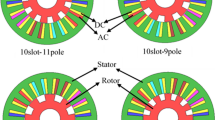Abstract
This paper discusses the issue of safe operating speed torque zone and field weakening in electrical machines from a somewhat different viewpoint than in the existing literature, including textbooks. At present, field weakening in electrical machines is viewed as an issue due to limitation of available input voltage which prevents a desired current to flow into the motor due to back emf at high speeds. This issue, along with the issue of safe operating zone, is examined in this paper with elaborations on the total loss in the machine which includes magnetic loss, copper loss, and also rotational and windage losses. The author believes that this gives a more complete and accurate picture of the situation and leads to a more scientifically accurate reasoning towards implementation of field weakening (if necessary), and also describing the safe operating zone in electrical machines.


Similar content being viewed by others
References
Patil N (2009) Field weakening operation of AC machines for traction drive applications. Ph.D. dissertation, University of Tennessee, Knoxville, Tennessee
Cǎpitan C (2009) Torque control in field weakening mode. Master Thesis, Group PED4-1038C, Institute of Energy Technology Aalborg University
Meier S (2002) Theoretical design of surface-mounted permanent magnet motors with field-weakening capability. Master Thesis, Royal Institute of Technology, Department of Electrical Engineering, Electrical Machines and Power Electronics, Stockholm
Soong W, Miller T (1994) Field-weakening performance of brushless synchronous AC motor drives. IEE Proc-Electr Power Appl 141(6):331–340
Xu X, Novotny D (1992) Selection of the flux reference for induction machine drives in the field weakening region. IEEE Trans Ind Appl 28(6):1353–1358
Kim S, Sul S (1995) Maximum torque control of an induction machine in the field weakening region. IEEE Trans Ind Appl 31(4):787–794
Chen Y, Pillary Y (2002) An improved formula for lamination core loss calculations in machines operating with high frequency and high flux density excitation. IEEE Ind App Conf 2:759–766
Krause P, Wasynczuk O, Sudhoff S (1995) Analysis of electric machinery. IEEE Press, New York
Nasar S, Unnewehr L (1983) Electromechanics and electric machines, 2nd edn. Wiley, London
Huynh C, Zheng L, Acharya D (2008) Losses in high speed permanent magnet machines used in microturbine applications. J Eng Gas Turbines Power 131(2):022301–022306
Kim S, Sul S (1997) Voltage control strategy for maximum torque operation of an induction machine in the field-weakening region. IEEE Trans Ind Electron 44(4):512–518
Jahns T (1987) Flux weakening regime operation of an interior permanent magnet synchronous motor drive. IEEE Trans Ind Appl 23:681–689
Baily J, Lawler J, Blake H (1999) Field-weakening schemes and magnet-retention techniques for permanent magnet machines. Oak Ridge National Lab., Unpublished ORNL-TM 74
Magnussen F, Thelin P, Sadarangani C (2004) Performance evaluation of permanent magnet synchronous machines with concentrated and distributed windings including effect of field weakening. In: Proceedings of 2nd IEE International Conference on Power Electronics, Machines and, Drives, vol. 2, March/Apr 2004, pp. 679–685
Harnefors L, Pietilainen K, Gertmar L (2001) Torque-maximizing field-weakening control: design, analysis, and parameter selection. IEEE Trans Ind Electron 48(1):161–168
Jung S, Mi C, Nam K (2015) Torque control of IPMSM in the field-weakening region with improved DC-link voltage utilization. IEEE Trans Ind Electr 62(6):3380–3387
Nalepa R, Orlowska-Kowalska T (2012) Optimum trajectory control of the current vector of a nonsalient-pole PMSM in the field-weakening region. IEEE Trans Ind Electr 59(7):2867–2876
Tripathi, A, Khambadkone, A, Panda, S (2003) Dynamic torque control performance of the direct flux control scheme in field weakening range, Industrial Electronics Society, 2003. In: IECON 29th Annual Conference of the IEEE, vol. 1, pp. 220–225
Yahia H, Dhifaoui R, Multon B (2000) Maximum power limits in the field-weakening mode of doubly-salient variable reluctance machines, Industrial Electronics Society, 2000, IECON. In: 26th Annual Conference of the IEEE, vol. 2, pp. 783–788
Author information
Authors and Affiliations
Corresponding author
Rights and permissions
About this article
Cite this article
Masrur, M.A. Perspectives on safe operating region and field weakening operation in electrical machines. Electr Eng 100, 231–238 (2018). https://doi.org/10.1007/s00202-016-0490-2
Received:
Accepted:
Published:
Issue Date:
DOI: https://doi.org/10.1007/s00202-016-0490-2




